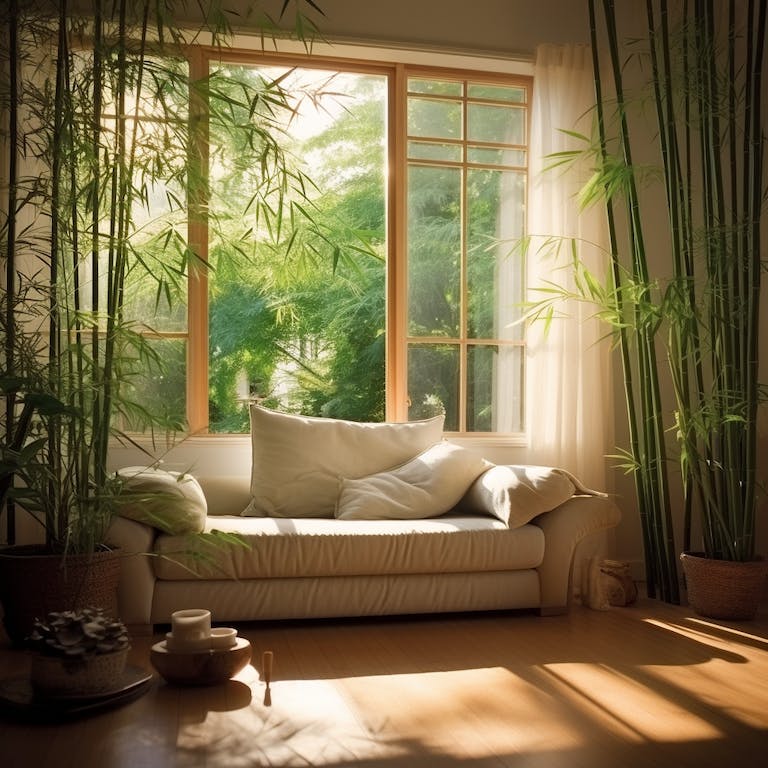If you’ve ever found yourself drawn to the graceful allure of indoor bamboo, you’re in for a treat. Cultivating and caring for these elegant plants is not only a delightful pastime but also a surefire way to bring a touch of nature into your living space.
In this beginner’s guide, we’ll unravel the secrets to keeping your indoor bamboo thriving and happy. No green thumb required – just a sprinkle of enthusiasm and a dash of simple care practices.
Let’s embark on this green journey together, unlocking the joys of nurturing your very own bamboo haven right at home. So, roll up your sleeves and get ready to discover the ins and outs of pampering your indoor bamboo plant!
Contents
- 1 Choosing an Appropriate Planter
- 2 Watering an Indoor Bamboo Plant
- 3 Fertilizing an Indoor Bamboo Plant
- 4 Lighting Needs for Indoor Bamboo
- 5 Choosing the Right Type of Bamboo
- 6 Considerations for Growing an Indoor Bamboo Plant
- 7 Conclusion:
- 8 FAQs
- 8.1 How much sunlight does my indoor bamboo need?
- 8.2 How often should I water my indoor bamboo?
- 8.3 What type of soil is best for indoor bamboo?
- 8.4 Can I use tap water for my indoor bamboo?
- 8.5 Do I need to fertilize my indoor bamboo?
- 8.6 How do I prevent my indoor bamboo from becoming leggy?
- 8.7 Should I repot my indoor bamboo, and how often?
Choosing an Appropriate Planter
When you’re ready to take your bamboo plant from the nursery and pot it up at home, you need to choose an appropriate planter. The planter you choose should be wide and shallow rather than deep and narrow. Bamboo plants have roots that grow horizontally, not vertically like most plants.
If you pot them up in a deep and narrow planter, their roots will become crowded and they’ll be more likely to tipping over. A wide and shallow planter will give the roots plenty of room to grow.
There are a few other things you need to keep in mind when choosing a planter for your bamboo plant. The planter should have drainage holes in the bottom so that excess water can drain out. Bamboo plants don’t like to sit in wet soil. If the roots sit in wet soil for too long, they can rot.
The planter should also be made from a breathable material like ceramic, terracotta, or wood. Bamboo plants don’t like to be in hot, stuffy environments. A breathable planter will help to keep the roots cooler and the plant healthy.
Once you’ve chosen an appropriate planter, it’s time to pot up your bamboo plant. Be sure to use a well-draining potting mix and water the plant well. You can find more tips on potting and caring for bamboo plants in our guide to growing bamboo indoors.

Watering an Indoor Bamboo Plant
Indoor bamboo plants are a beautiful and unique addition to any home. But, like all plants, they need the right amount of water to thrive. Over-watering is one of the most common problems people have with indoor bamboo plants. So, how do you take care of an indoor bamboo plant?
The first thing to understand is that different types of bamboo plants have different water needs. Some types of bamboo can tolerate long periods of drought, while others need more frequent watering. When in doubt, it’s always better to err on the side of too little water rather than too much.
To water your indoor bamboo plant, simply use a watering can or a gentle hose attachment to give it a good drink. Be sure to soak the roots thoroughly, and then allow the plant to drain for a few minutes before putting it back in its pot.
Indoor bamboo plants also appreciate a humid environment, so misting the leaves with a spray bottle of water is also a good idea. Just be sure not to over-do it, or you could end up with mold or mildew problems.
If you’re not sure how often to water your indoor bamboo plant, check the soil before each watering. If it feels dry to the touch, it’s time to give it a drink. In general, most indoor bamboo plants need to be watered every one to two weeks.
Remember, too much water is just as bad as too little, so it’s important to check the soil before watering and only give your plant as much as it needs. With a little care and attention, your indoor bamboo plant will thrive for years to come!
Fertilizing an Indoor Bamboo Plant
When it comes to fertilizing an indoor bamboo plant, you want to use a fertilizer that is high in nitrogen. This will help to encourage growth. You can either use a liquid fertilizer or a granular fertilizer. If you use a granular fertilizer, you will need to water it in well so that the roots can get to the nutrients.
You should fertilize your bamboo plant every two to four weeks during the growing season. When the weather starts to cool down in the fall, you can fertilize every six to eight weeks. You don’t need to fertilize your bamboo plant during the winter months when it is dormant.
If you notice that your bamboo plant is not growing as much as it should be, you can give it a boost by using a fertilizer with a higher nitrogen content. You should also make sure that you are watering your plant regularly and not letting it dry out.

Lighting Needs for Indoor Bamboo
Most people don’t think of bamboo as a houseplant, but it can actually make a beautiful and unusual addition to your indoor décor. Bamboo is a type of grass, and there are many different varieties that can be grown indoors. Some varieties can get quite large, so it’s important to choose one that will fit well in your space.
Bamboo does best in bright, indirect light. It will tolerate some direct sun, but too much sun can scorch the leaves. If your bamboo is getting too much sun, you’ll notice the leaves turning yellow or brown.
To keep your bamboo healthy, you’ll need to water it regularly. Water it when the soil feels dry to the touch, and be sure to drain any excess water from the saucer so that the roots don’t sit in water.
Bamboo is a relatively low-maintenance plant, but it does need to be fertilized every few weeks during the growing season. Use a good quality liquid fertilizer and follow the directions on the package.
If you’re looking for an interesting and unusual plant to add to your indoor décor, bamboo is a great choice. Just be sure to give it the right growing conditions and you’ll have a beautiful plant that will thrive for years.
Choosing the Right Type of Bamboo
Choosing the right type of bamboo can be tricky. There are many different types of bamboo, and each type has its own set of care requirements. Bamboo is a fast-growing grass that can reach heights of up to 100 feet in the wild. Bamboo is often used in construction, as a food source, and in traditional medicines.
The most common type of bamboo is the Phyllostachys genus, which is native to China. This type of bamboo is the most popular choice for indoor bamboo plants. Phyllostachys bambusoides, or timber bamboo, is the most widely planted bamboo in the world. Timber bamboo can grow up to 50 feet tall and is often used in construction.
Another common type of bamboo is Fargesia. Fargesia are native to the Himalayan region and are much smaller than Phyllostachys bamboo. Fargesia only grow to about 10 feet tall and are often used as privacy screens or hedges.
Bambusa is a genus of bamboo that is native to tropical and subtropical regions. Bambusa are some of the largest bamboo, with some species reaching heights of up to 100 feet. Bambusa are often used in construction and for making furniture.
Dendrocalamus is a genus of bamboo that is native to Southeast Asia. Dendrocalamus are the tallest bamboo, with some species reaching heights of up to 150 feet. Dendrocalamus are often used in construction and for making furniture.

Considerations for Growing an Indoor Bamboo Plant
As the popularity of bamboo plants continue to grow, more and more people are looking to keep them as indoor plants. There are a few things to consider before growing an indoor bamboo plant to make sure it thrives.
First, you need to make sure that you have enough space for your bamboo plant. It is important to give them enough room to grow as they can get quite large. If you do not have enough space, you may need to consider keeping them in a pot.
Secondly, you need to make sure that you have the proper lighting for your bamboo plant. They prefer bright, indirect light but can also tolerate low light conditions. If you do not have enough light, they may not grow as large as they could.
Third, you need to make sure that you water your bamboo plant regularly. They like to be kept moist but not wet. Overwatering can lead to root rot, so be sure to check the soil before watering.
Finally, you need to make sure that you fertilize your bamboo plant regularly. A good general rule is to fertilize every two weeks during the growing season and every month during the winter.
By following these simple tips, you can make sure that your bamboo plant thrives indoors.

Conclusion:
In cocnlusion, taking care of an indoor bamboo plant is not difficult. The plant does not need a lot of water and can tolerate some neglect.
However, there are a few things you should keep in mind to help your plant thrive. Be sure to give it plenty of bright, indirect light and water when the soil is dry.
You may also want to fertilize your plant every few months to give it a boost. With a little care, your bamboo plant will grow tall and strong, adding a touch of nature to your home.
I hope this article has helped you to better understand how to care for an indoor bamboo plant. As you can see, it is not difficult, but there are a few things to keep in mind. With a little care and attention, your bamboo plant will thrive and bring you years of enjoyment.
FAQs
How much sunlight does my indoor bamboo need?
Indoor bamboo plants thrive in bright, indirect light. Place them near a window where they can get filtered sunlight. Avoid direct exposure to harsh sunlight, as it may scorch the leaves.
How often should I water my indoor bamboo?
Keep the soil consistently moist, but not waterlogged. Water when the top inch of the soil feels slightly dry. Be mindful not to let the soil completely dry out, as bamboo prefers consistently moist conditions.
What type of soil is best for indoor bamboo?
Use a well-draining potting mix with good aeration. A mix designed for tropical plants or orchids can work well. Make sure the pot has drainage holes to prevent waterlogging.
Can I use tap water for my indoor bamboo?
While tap water is generally fine, it’s best to let it sit for 24 hours before using to allow chlorine to dissipate. Bamboo prefers slightly acidic to neutral pH levels in the soil.
Do I need to fertilize my indoor bamboo?
Yes, but sparingly. Feed your bamboo with a balanced, diluted liquid fertilizer every 2-4 weeks during the growing season (spring and summer). Reduce or eliminate fertilization in fall and winter.
How do I prevent my indoor bamboo from becoming leggy?
To encourage a bushier growth, prune the tops of the canes when they reach the desired height. This promotes lateral growth and denser foliage.
Should I repot my indoor bamboo, and how often?
Repot your bamboo when it outgrows its current container, typically every 2-3 years. Choose a pot that is 2 inches larger in diameter and replace the soil to refresh nutrients.







